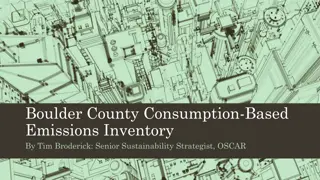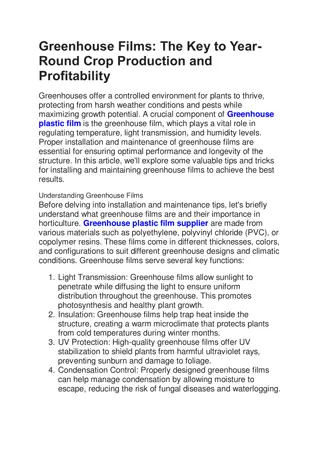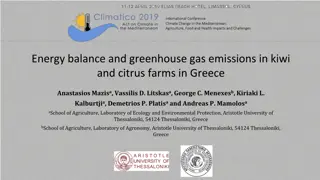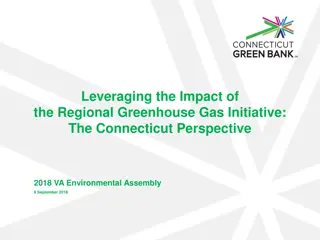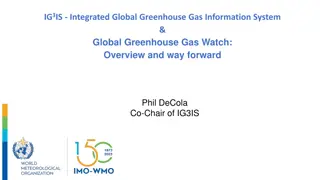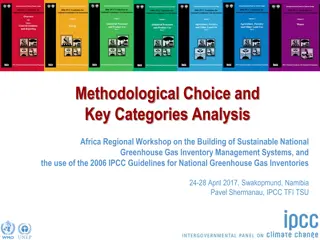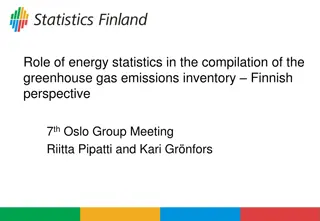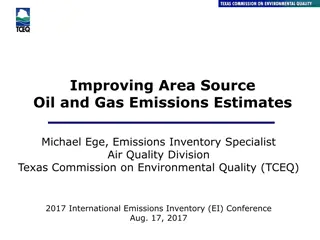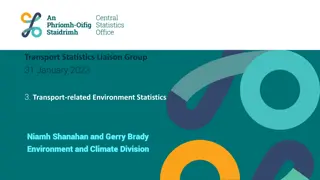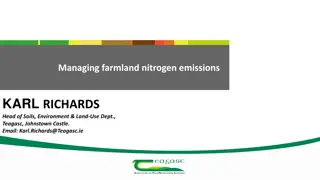Tracking Progress of Mitigation Commitments and Greenhouse Gas Emissions Projections
Explore the journey of tracking progress on mitigation commitments, projections of greenhouse gas emissions, and scenarios for future projections. Learn about the importance of developing projections, quality control, and reporting scenarios for various policy measures. Discover tools available for developing projections and evaluating models. Stay informed and take action towards sustainable environmental practices.
Download Presentation

Please find below an Image/Link to download the presentation.
The content on the website is provided AS IS for your information and personal use only. It may not be sold, licensed, or shared on other websites without obtaining consent from the author.If you encounter any issues during the download, it is possible that the publisher has removed the file from their server.
You are allowed to download the files provided on this website for personal or commercial use, subject to the condition that they are used lawfully. All files are the property of their respective owners.
The content on the website is provided AS IS for your information and personal use only. It may not be sold, licensed, or shared on other websites without obtaining consent from the author.
E N D
Presentation Transcript
Tracking Progress of the Mitigation Commitments of Nationally Determined Contributions (NDCs) Dominic Sheldon Presentation: Projections and Mitigation tracking Ricardo Energy & Environment
PATPA Publication on Projections Contents 1) 2) 3) 4) The importance of developing projections Basic approach to developing GHG projections Quality Assurance and Quality Control Refining the projection s approach over time https://transparency-partnership.net/publications-tools/projections- greenhouse-gas-emissions-and-removals-introductory-guide
Scenarios for projections of greenhouse gas emissions and removals
Reporting projections: Scenario types Scenario Baseline scenario Mitigation Scenario If provided, it excludes all policies and measures implemented, adopted and planned after the year chosen as the starting points for the projections ("may requirement") Without measures (WOM) With existing measures (WEM) Encompasses currently implemented and adopted policies and measures ("shall requirement") Encompasses implemented, adopted and planned policies and measures ("may requirement") With additional measures (WAM) Source: EEA Projections in hindsight (2015)
Developing projections No standardised methodologies or tools exist to allow GHG projections to be calculated. There are several modelling approaches/tools available which can help with this task.
Model evaluation table General Equilibrium (CGE) Models Input Output (I/O) Models Evaluation Dimensions Simulation Models Optimisation Models Accounting Models Scope of Analysis Macro-economic Sectoral Sector-specific Energy Systems Energy Systems Short to Medium-term (5- 15 years) Temporal Perspective Long-term (Multi-year) Short to Medium-term Long-term (40-50 years) Flexible Behavioural Realism Moderate Low High Moderate Low Technological Detail Low Low High High Moderate Ease of Use Complex Moderate Moderate Complex Simple to Moderate Cost Consideration Yes Partial Yes Comprehensive Yes Policy Impact Sensitivity High Moderate High High Moderate Flexibility Low Low Moderate Moderate High MARKAL/TIMES, MESSAGE Examples EPPA, ICES IOTA, REMI POLES, AERO LEAP, GACMO
Choosing a model type Question Impacts and costs of planned mitigation actions? All model types (for impacts) and some Suggested Model Type Example of Model Type to Use E.g., Any listed model type model types for costs Effects of mitigation actions on economic development/job creation? E.g., General Equilibrium Models Top-down macro-economic models Most cost-effective pathway to achieve target? Optimisation models E.g., TIMES Forecast of future emissions? Accounting models E.g., LEAP Bottom-up simulation models E.g., POLES Evolution of emissions in a specific sector? Sectoral accounting models E.g., EX-ACT Modeling a long-term target? Hybrid modelling tools Hybrid Models Quick assessment of mitigation actions with limited expertise/data? Using the same model over time with limited data/expertise? Simple accounting tools E.g., GACMO Accounting tools E.g., PROSPECTS+
Developing projections Inputs: Outputs: GHG Results: Forecasts of total and sector-specific GHG emissions and trend analysis. Non-GHG Results: Evaluations of other environmental impacts and socio-economic outcomes. Policy Evaluation: Analysis of the potential impact of proposed policies on GHG emissions and suggestions for policy modifications or new strategies. 1. Historical Data 1. Historical Drivers: Economic indicators (like GDP), demographic data, energy usage trends, and changes in land use. Historical Emissions: Activity data including energy and industrial activities, and respective emissions factors. Non-emissions Data: Additional environmental data (e.g., deforestation rates) and socio-economic data. 2. 3. 2. Projected Data 1. Drivers: Predictions on economic growth, demographic changes, and energy price fluctuations. Policies: Forthcoming government policies and industry standards regarding emissions reductions. 2. 3. Tracking Data 1. 2. Assumptions: Economic and technological predictions for the future. Definition of Indicators: Criteria to gauge progress, such as GHG emissions reduction and energy efficiency improvement.
Reporting projections The assessment of projections has only been reported by the developed countries as part of their National Communications/ Biennial Reports to the UNFCCC. As indicated in the most recent UNFCCC reporting guidelines on national communications for Parties included in Annex I to the UNFCCC (Decision 6/CP25 of 2019), "the primary objective of the projections section of the national communication is to give an indication of future trends in GHG emissions and removals, given current national circumstances and implemented and adopted policies and measures, and to give an indication of the path of emissions and removals without such policies and measures."
Reporting projections under the ETF Para MPGs Type Requirement 92 Shall / Encouraged Report projections with flexibility for developing countries 93 Shall Indicative of the impact of PaMs, not for progress assessment unless specified 94 Shall / May Report 'with measures' projection and optionally others 95 Shall Projections to start from most recent year and extend at least 15 years, with flexibility for developing countries 96 Should Methodology description including models, changes, assumptions, and sensitivity analysis 97 Shall Provide projections of key indicators for NDC progress 98 Shall Include sectoral, by gas and national total projections using a consistent metric 99 Shall Present projections relative to actual inventory data 100 Shall Provide emission projections with and without LULUCF 101 Shall Present projections in graphical and tabular formats
Flexibility provisions available for developing countries for projections REFERENCE IN THE MPGS (ANNEX TO DECISION 18/CMA.1) FLEXIBILITY PROVISION FOR THOSE DEVELOPING COUNTRY PARTIES THAT NEED IT IN THE LIGHT OF THEIR CAPACITIES PROVISION IN THE MPGS Paragraph 92 Those Parties that need flexibility are instead encouraged to report these projections. Each Party shall report projections GHG emission and removals projections Projections shall begin from the most recent year in the Party s national inventory report and extend at least 15 years beyond the next year ending in zero or five Those Parties that need flexibility have the flexibility to instead extend their projections at least to the end point of their NDC under Article 4 of the Paris Agreement. Paragraph 95 Projections extension Paragraph 102 See paragraphs 93 through 101 of the annex to decision 18/CMA.1 Those Parties that need flexibility can instead report using a less detailed methodology or coverage. Projections methodology or coverage
Reporting projections under the ETF 102. Those developing country Parties that need flexibility in the light of their capacities with respect to paragraphs 93 101 above can instead report using a less detailed methodology or coverage. less detailed methodology or coverage.
Reporting projections under the ETF Para MPGs Type FX Requirement Shall / Encouraged 92 Report projections with flexibility for developing countries FX 93 Shall Indicative projections, not for progress assessment unless specified FX 94 Shall / May Report 'with measures' projection and optionally others FX 95 Shall Projections to start from recent year and extend at least 15 years, with flexibility for developing countries FX 96 Should Methodology description including models, changes, assumptions, and sensitivity analysis FX 97 Shall Provide projections of key indicators for NDC progress FX 98 Shall Include sectoral, by gas and national total projections using a consistent metric FX 99 Shall Present projections relative to actual inventory data FX 100 Shall Provide emission projections with and without LULUCF FX 101 Shall Present projections in graphical and tabular formats FX
Thank you! Dominic Sheldon Dominic.Sheldon@Ricardo.com Ricardo



